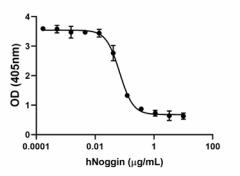- Regulatory Status
- RUO
- Other Names
- Nog, SYNS1A, SYNS1, SYM1

-

Recombinant human Noggin inhibits alkaline phosphatase production induced by recombinant human BMP-4 in the chondrogenic cell line ATDC5. The ED50 for this effect is 0.04 – 0.20 µg/mL. -

Stability Testing for Recombinant Human Noggin. Recombinant human Noggin was aliquoted in 10 mM citric acid, pH 3.0. One aliquot was frozen and thawed four times (4x Freeze/Thaw) and compared to the control that was kept at 4⁰C (Control). The samples were tested for their ability to inhibit alkaline phosphatase production induced by recombinant human BMP-4 in the chondrogenic cell line ATDC5. The ED50 for this effect is 0.04 – 0.20 µg/mL.
| Cat # | Size | Price | Quantity Check Availability | ||
|---|---|---|---|---|---|
| 795904 | 25 µg | $229.00 | |||
| 795906 | 100 µg | $844.00 | |||
Select size of product is eligible for a 40% discount! Promotion valid until December 31, 2024. Exclusions apply. To view full promotion terms and conditions or to contact your local BioLegend representative to receive a quote, visit our webpage.
Noggin is an embryonic inducer that can sequester TGF-β cytokines of the BMP family with extremely high affinity. This protein was originally identified as a BMP-4 antagonist whose action is critical for proper formation of the head and other dorsal structures. Noggin has also been shown to modulate the activities of other BMPs including BMP-2, -7, -13, and -14. It is expressed in defined areas of the adult central nervous system and peripheral tissues such as lung, skeletal muscle, and skin. During culture of human embryonic stem cells (hESC) or neural stem cells under certain conditions, addition of Noggin to antagonize BMP activity may allow stem cells to proliferate while maintaining their undifferentiated state, or alternatively, to differentiate into dopaminergic neurons. Noggin also appears to maintain adult stem cell populations in vivo. For example, it maintains neural stem cells within the hippocampus. Targeted deletion of Noggin in mice results in prenatal death and a recessive phenotype displaying a severely malformed skeletal system. Conversely, transgenic mice over-expressing Noggin in mature osteoblasts display impaired osteoblastic differentiation, reduced bone formation, and severe osteoporosis.
Product Details
- Source
- Human Noggin, amino acid (Gln28-Cys232) (Accession: # Q13253), was expressed in E.coli.
- Molecular Mass
- The 206 amino acid recombinant protein has a predicted molecular mass of approximately 23.17 kD. The DTT-reduced and non-reduced protein migrates at approximately 28 and 70 kD by SDS-PAGE, respectively. The predicted N-terminal amino acid is Gln.
- Purity
- > 95%, as determined by Coomassie stained SDS-PAGE
- Formulation
- 0.22 µm filtered protein solution is 10 mM citric acid, pH3.
- Endotoxin Level
- Less than 0.1 EU per µg cytokine as determined by the LAL method
- Concentration
- 10 and 25 µg sizes are bottled at 200 µg/mL. 100 µg size and larger sizes are lot-specific and bottled at the concentration indicated on the vial. To obtain lot-specific concentration and expiration, please enter the lot number in our Certificate of Analysis online tool.
- Storage & Handling
- Unopened vial can be stored between 2°C and 8°C for up to 2 weeks at -20°C for up to six months, or at -70°C or colder until the expiration date. For maximum results, quick spin vial prior to opening. The protein can be aliquoted and stored at -20°C or colder. Stock solutions can also be prepared at 50 - 100 µg/mL in appropriate sterile buffer, carrier protein such as 0.2 - 1% BSA or HSA can be added when preparing the stock solution. Aliquots can be stored between 2°C and 8°C for up to one week and stored at -20°C or colder for up to 3 months. Avoid repeated freeze/thaw cycles.
- Activity
- Recombinant human Noggin inhibits alkaline phosphatase production induced by recombinant human BMP-4 in the chondrogenic cell line ATDC5. The ED50 for this effect is 0.04 – 0.20 µg/mL.
- Application Notes
-
BioLegend carrier-free recombinant proteins provided in liquid format are shipped on blue-ice. Our comparison testing data indicates that when handled and stored as recommended, the liquid format has equal or better stability and shelf-life compared to commercially available lyophilized proteins after reconstitution. Our liquid proteins are validated in-house to maintain activity after shipping on blue ice and are backed by our 100% satisfaction guarantee. If you have any concerns, contact us at tech@biolegend.com.
-
Application References
(PubMed link indicates BioLegend citation) -
Bioassay
Antigen Details
- Structure
- Dimer
- Distribution
-
Preadiposites, skeletal muscle, lung, neuron, skin, adipose tissue, osteoblasts.
- Function
- Regulates mainly the function of BMP-2, BMP-4, and BMP-7. Controls the development of bone, muscle, and nerve tissue among others. Modulate adipose tissue and obesity in vivo.
- Interaction
- Mesenchymal stem cells, embryonic stem cells
- Ligand/Receptor
- BMP-2, BMP-4, BMP-5, BMP-6, BMP-7, BMP-13, and BMP-14
- Bioactivity
- Recombinant mouse Noggin inhibits alkaline phosphatase production induced by human BMP-4 in the chondrogenic cell line ATDC5.
- Antigen References
-
1. Valenzuela DM, et al. 1995. J. Neurosci. 15:6077.
2. McMahon JA, et al. 1998. Genes Dev. 12:1438.
3. Yuasa S, et al. 2005. Nat. Biotechnol. 23:607.
4. Gong Y, et al. 1999. Nat. Genet. 21:302.
5. Chiba S, et al. 2008. Stem Cells 26:2810.
6. Bonaguidi MA, et al. 2008. J. Neurosci. 28:9194.
7. Hu X, et al., 2012 J Dent Res 91:394.
8. Blázquez-Medela AM, et al., 2019, Mol Met 25: 50.
9. Blázquez-Medela AM, et al., 2019, Obes Rev. 20:648. - Gene ID
- 9241 View all products for this Gene ID
- UniProt
- View information about Noggin on UniProt.org
